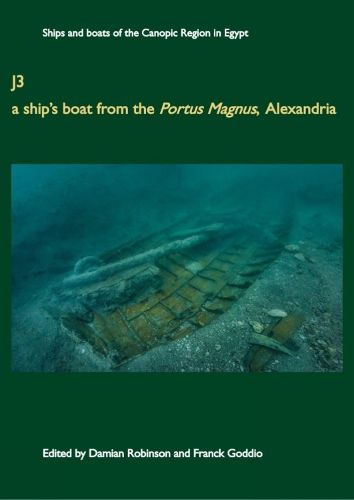J3: A Ship's Boat from the Portus Magnus, Alexandria

J3: A Ship’s Boat from the Portus Magnus, Alexandria
J3, a small boat around 6 metres long, was discovered by the Institut Europeen d'Archeologie Sous-Marine (IEASM) in the Eastern Harbour of Alexandria, the ancient Portus Magnus. The boat, dating to the 1-2nd century AD, was discovered towards the northeastern end of Antirhodos Island in the sheltered inner harbour, well preserved in the sediments.
The excavation allowed a team from the IEASM to study the wreck in detail, to reveal the details of the construction of this transom sterned vessel. The ship was flat-bottomed with a prominent keel, the surviving length of which was 4.4 m long. The port side was completely preserved in the centre of the boat from the keel through fourteen strakes to the guard rail. Due to the angle that it came to rest on the harbour bottom, only six lines of strakes were preserved on the starboard of J3. The boat was constructed with a well-developed internal structure with 21 preserved frames. The carvel planking of the ship was assembled with mortise-and-tenon joints cut in the middle of the edges of the planks.
The preservation of J3 was such that the remains of two thwarts were discovered still in situ with evidence to indicate the presence of a third rowing bench. These were accompanied by three thole pins set into the guard rail and the final lines of strakes. The boat was preserved with a mast-step, indicating that it could be sailed as well as rowed.
A wide variety of carefully chosen wood species were used in its construction and as is typical for the Roman period hard woods used for the keel and frames and softwoods for the planking. These species were not native to Egypt, nor were several of them used in shipbuilding in the eastern Mediterranean during the Roman period. Instead, the suite of timbers used would suggest that J3 originated in a boatyard on the Tyrrhenian coast of Italy.
J3 was transporting a large iron anchor at the moment it sank. This occupied almost the entire preserved length of the ship and was carefully positioned with its crown on the decked aft area and the shank under the removable thwarts. It had been disassembled before stowage in J3 with the stock removed and carefully placed in the bottom of the boat. While typologically similar anchors have also been found in anchorages outside of the Portus Magnus, the majority of this type have been found in the western Mediterranean. The evidence points towards the interpretation that J3 was a ship’s boat, made somewhere on the coast of the Tyrrhenian Sea that sank carrying a large anchor that was likely also made in region. Papyrus Bingen 77 (P.Mich. 5760a) records the arrival of ship on the Ostia-Alexandria route, a vessel that would have returned to Italy taking grain and luxuries from the east to the heart of the Roman empire. J3 most likely reached the Portus Magnus either aboard or towed behind a similar trading ship. This volume consequently brings more information on the construction of transom-sterned boats and how they would have been used in the activities of the great port of Alexandria.
Order online and we’ll ship when available
Our stock data is updated periodically, and availability may change throughout the day for in-demand items. Please call the relevant shop for the most current stock information. Prices are subject to change without notice.
Sign in or become a Readings Member to add this title to a wishlist.


